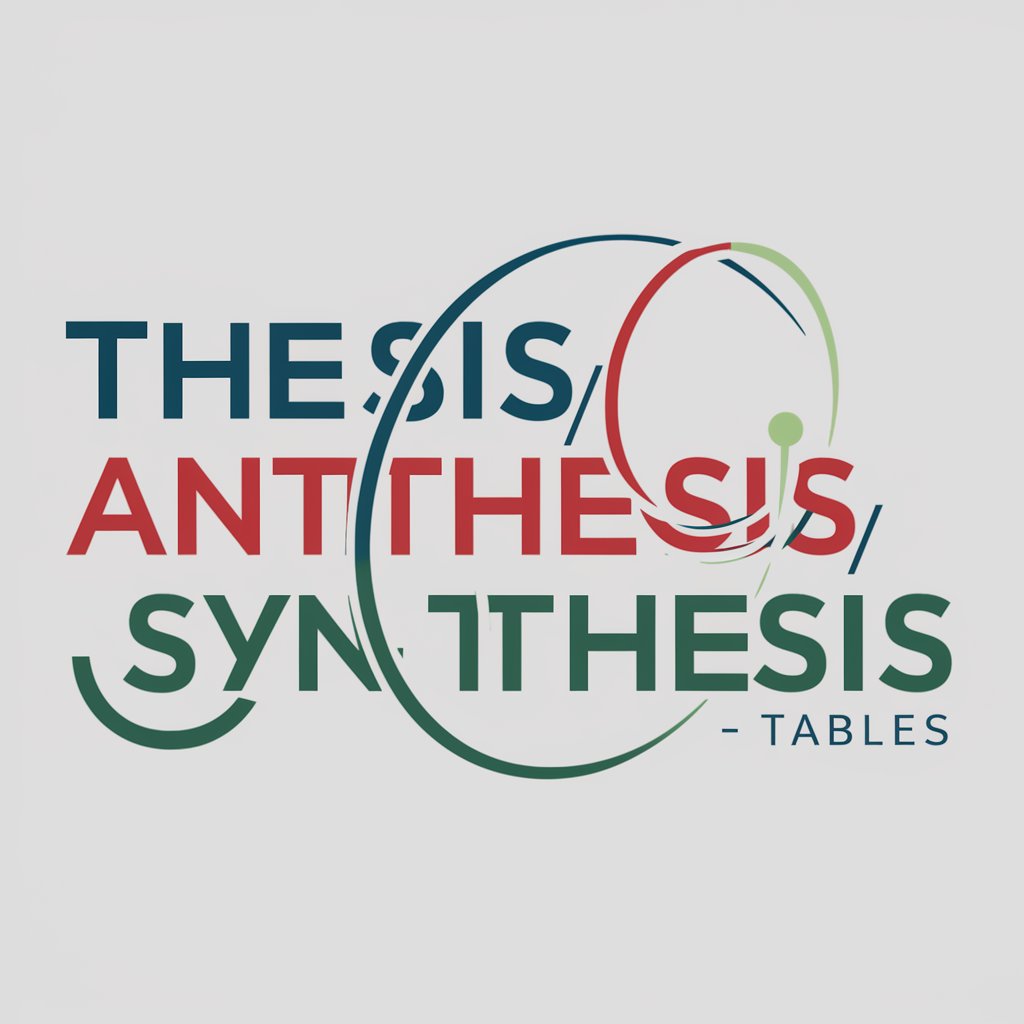Thesis/Antithesis/Synthesis - Tables - Dialectical Analysis Tool

Welcome! Let's delve into the art of dialectical synthesis together.
Synthesizing Ideas, Resolving Contradictions
Explore the concept of...
Analyze the opposing viewpoints on...
Discuss the synthesis of...
Evaluate the thesis and antithesis regarding...
Get Embed Code
Overview of Thesis/Antithesis/Synthesis - Tables
Thesis/Antithesis/Synthesis - Tables represent a structured approach to discourse, based on the philosophical model often attributed to Hegel. This model encapsulates dialectical thinking, where an idea (thesis) meets a contrasting idea (antithesis), culminating in a merged or reconciled idea (synthesis). These tables are designed to visually break down complex arguments or debates into these three components, aiding in clearer understanding and resolution. For instance, in a debate about urban development, the thesis might advocate for extensive commercial construction, the antithesis might emphasize the preservation of green spaces, and the synthesis might propose a balanced development plan that includes both commercial spaces and green areas. Powered by ChatGPT-4o。

Functions of Thesis/Antithesis/Synthesis - Tables
Facilitating Structured Debate
Example
In a policy discussion, participants use the table to clearly outline their positions and the opposing views, leading to a more informed and constructive synthesis.
Scenario
A city council uses the table to debate a new public transport policy, with one side advocating for more roads (thesis), another for more public transit (antithesis), and finding a synthesis in a mixed solution.
Educational Tool
Example
Teachers use these tables to help students understand complex philosophical, political, or social debates by breaking them down into their fundamental components.
Scenario
In a classroom, a teacher explains the concepts of capitalism (thesis) and socialism (antithesis), and then guides students towards understanding social democracy (synthesis).
Conflict Resolution
Example
In corporate or organizational settings, the table is used to resolve conflicts by identifying and reconciling opposing viewpoints.
Scenario
During a company meeting, differing opinions about a new product's features (thesis and antithesis) are reconciled into a final design (synthesis) that satisfies both parties.
Ideal Users of Thesis/Antithesis/Synthesis - Tables
Academics and Students
These users benefit from the structured approach to dissecting and understanding complex theories and arguments, making it an invaluable tool in educational settings.
Policy Makers and Politicians
These individuals often engage in debates where clearly defining opposing views and finding middle ground is crucial for effective policy formulation and political negotiation.
Business Professionals
In business, especially in areas like strategy development and conflict resolution, the ability to clearly articulate different positions and find a harmonious resolution is key to successful decision-making.

Guidelines for Using Thesis/Antithesis/Synthesis Tables
1
Visit yeschat.ai for a free trial without login, also no need for ChatGPT Plus.
2
Identify a topic or debate that involves contrasting viewpoints or arguments.
3
Articulate the thesis and antithesis by clearly stating the opposing views on the topic.
4
Utilize the table format to systematically compare and contrast these viewpoints.
5
Develop a synthesis that reconciles or merges the key aspects of the thesis and antithesis into a new, unified perspective.
Try other advanced and practical GPTs
LaLaLa
Craft Your Music, Powered by AI

TubeGPT
Elevating Videos with AI-Powered SEO

MATH PLAYER
Elevating Math Understanding with AI

The International Baccalaureate Buddy (IB Buddy)
Empowering Polymath Exploration with AI

Learn Khmer with GPT
Empowering language mastery with AI.

Learn Portuguese with GPT
Master Portuguese with AI-powered guidance.

Aussie Accountant
Empowering your finance with AI

CFA Mentor
AI-Powered CFA Learning Companion

Neo Turing
Engage with Intelligence, Banter with Brilliance

Is My Data Beautiful?
Transform data into visual stories with AI

Qlik Sense Advisor
AI-Powered Qlik Sense Expertise at Your Fingertips

Grab a Beer with Anyone
Converse with any personality, powered by AI

Frequently Asked Questions about Thesis/Antithesis/Synthesis Tables
What is the primary purpose of a Thesis/Antithesis/Synthesis table?
The primary purpose is to facilitate dialectical thinking, enabling users to explore, compare, and synthesize opposing viewpoints or arguments on a given subject.
Can this tool be used in academic research?
Absolutely. It's particularly useful for analyzing conflicting theories, constructing arguments, and synthesizing new ideas from existing literature.
How can this tool assist in conflict resolution?
By laying out opposing viewpoints (thesis and antithesis) and then guiding towards a compromise or a new perspective (synthesis), it aids in resolving conflicts through mutual understanding.
Is this tool suitable for beginners in philosophical studies?
Yes, it is designed to be user-friendly and is a valuable tool for anyone beginning to explore dialectical methods and philosophical analysis.
Can Thesis/Antithesis/Synthesis tables be applied in business settings?
Definitely. They can be used for strategic planning, resolving workplace conflicts, and in decision-making processes to consider various business strategies and outcomes.
